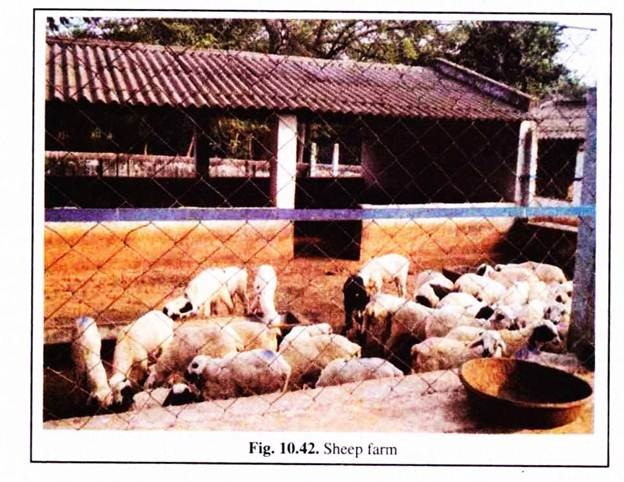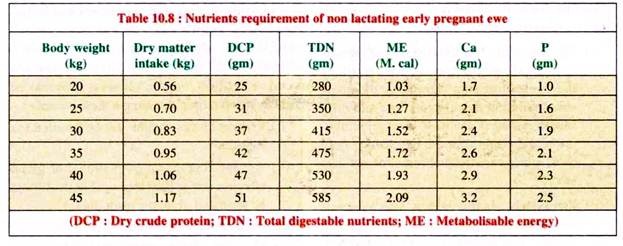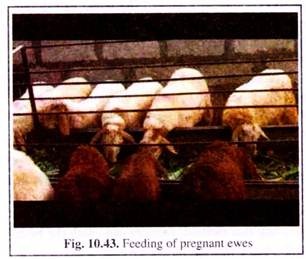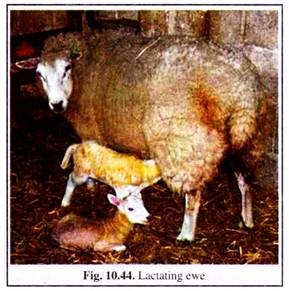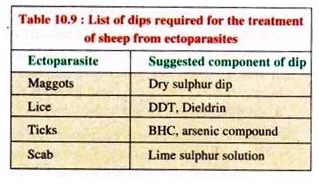In this article we will discuss about the rearing of sheep in a farm.
Selection and Purchase of Animal:
It is desirable to purchase healthy animals of 12-18 months of age. Crossbred sheep are available for purchase from State Government/Government of India sheep breeding farms. Ewes (female sheep) can be purchased in regular sheep markets or from breeders in villages, while rams (male sheep) of exotic/crossbred from Government farms. The animals purchased have to be identified by fixing ear tags.
Housing and Shelter Management:
Normally sheep do not require elaborate housing facilities but minimum provisions will definitely increase productivity, especially protection against inclement weather conditions (sun, rain and winds) and predation.
(i) Shed could be provided with gunny bags or temporary or removable protections made of thatching materials and bamboos. The roof of the shed should be made of asbestos sheet supported by tubular or angular steel. Wooden rafters and thatching materials could also be used (Fig. 10.42).
(ii) Exotic breeds should be provided with 0.9- 1.1 m2, and native and crossbred sheep with 0.8-0.9 m2 space per head. Sheds measuring 18m x 6m can accommodate about 120 sheep.
(iii) A chain link fencing or thorny bush enclosure of 12 m x 6 m can be provided for night paddocking of sheep on each side of the shed.
Feeding Management:
Sheep can survive well on natural grasses, shrubs and farm wastes. Maintaining sheep on concentrate is not the natural method. But increasing unavailability of adequate feeding and foraging areas poses a serious threat to sheep production. So, now it is obligatory to develop arid and semi-waste lands into pastures to provide the sheep top feed through plantation of fodder trees and grain shrubs.
Since sheeps are reared in flocks, so it is very difficult to feed either ewe or ram individually. So bulk of energy and other nutrient requirements are provided mostly from daily grazing.
ADVERTISEMENTS:
However, feed requirement of ewe flock varies during different stages of breeding cycle as follows:
(i) Feeding during Resting Period:
Ewes, not engaged in breeding purposes, are usually kept on a low level of feeding. If these ewes are maintaining their body weight to the extent of about 0.02 to 0.03 kg/day, they are on maintenance ratio. If they loose this ratio, their feed will be supplemented with additional concentrate mixture.
(ii) Feeding during Gestation Period:
ADVERTISEMENTS:
As the breeding season draws near, the ewes will again be put on better pastures. The amount of nutrients as shown in table 10.8 should be increased by 50 per cent to meet the requirement of fast growing foetus during last six weeks of gestation (total gestation period varies from 144 to 152 days).
During late stage of pregnancy, the ewes feed will be supplemented with 250 to 300 gm of any concentrate feed having about 25% DCP (Dry Crude Protein) and 75% TDN (Total Digestable Nutrients) to meet the demands of unborn lamb. This supplementation is known as “Steaming up”.
(iii) Feeding during Suckling Period:
After giving birth of lambs (baby sheep), the mother ewes must be properly fed so that they can produce sufficient quantities of milk to nurse the new born at least for 3 months.
The supplemented feed at this stage must be increased up to 500 gm either as gram chuni or a mixture of cereal grains and wheat bran in the ratio of 2: 1 along with legume hay from 1-2 kg. Mineral like cobalt salt other than common salt must be added with feed of lactating ewes.
For rams (male sheep), feeding system is same as that of ewes. During breeding season, they need supplementary feed from 250 to 500 gm of grain mixture consisting of crushed gram 2 parts, wheat bran 1 part and salt 1 part daily. Over-fatty ram should have reduced ration and plenty exercise.
Breeding Management:
Sheep generally attain reproduction maturity at about 2 years of age. According to breed and locality, this age, however, can vary. Female sheep or ewes are polyestrous. The cycle repeates every 16 days and heat period lasts for about 30 hours.
In India, three main mating seasons are observed for sheep; viz., Summer (March-April), Autumn (June-July) and post-monsoon (September- October). In plains, mating is high during autumn, while summer is the successful mating season in hilly areas.
ADVERTISEMENTS:
In farms, ewes need some special cares prior to breeding as follows:
(i) Extra feeding or flushing:
Two to three weeks prior to breeding season, ewes are given extra grain or lush pasture in order to make their ovary fully matured. Feeding about 250 gm grain per day has shown to increase in lamb crop by twin birth.
(ii) Removal of Wool:
For successful mating, locks of wool or tag should be removed from all over body, particularly at the region of reproductive organs of both ewe and ram. This process is referred to as ringing or tagging.
(iii) Eyeing:
In some breeds, wool around the eyes may hide the vision resulting in wool blindness. During mating season, this wool should be clipped away.
(iv) Marking:
Each mating pair of ram and ewe should be marked separately in the flock. It will help the farmers to identify the sterile sheep if present in the flock.
(v) Synchronisation of Heat:
It is now possible to make most of the adult ewe of the flock in heat or estrus stage within a desirable period. Such synchronisation of estrus or heat can be done by various methods. The most common practice is to insert a pessary containing a synthetic hormone, called Cronolone into the vagina of ewe by using a special instrument.
The hormone is gradually absorbed through vaginal wall into the blood and prevent ovulation. The pessary is then removed after certain period (15-17 days) by pulling the string attached to it. Within few days, most of the ewes come on heat when mating can be done by selected ram.
Synchronisation process is preferred as it helps the farm owner to plan the lambing time in suitable season and for easier management of flock. It also helps in breeding process by AI or hand mating. By adopting this method, farmers can catch the best/ particular marketing time of sheep.
Mating schedule:
Mating in sheep is usually done by following systems:
(i) Flock System:
Here, during mating season, rams are allowed to mate the ewes at will in the flock. However, fighting is the main chaos arised in this system. To avoid this, smaller mating flock (30-40 ewes per ram) is made, and young rams are selected for aged ewes while experienced rams for maiden ewes.
(ii) Pen System:
In this system, selected ewes and rams are kept in pen during night for mating. This system is mainly followed in stall fed sheep farm.
(iii) Hand Mating:
Ewes in estrus are first selected by the vasectomised rams who cannot fertilise but attempt to mate them. These ewes are then kept in separate pen with the selected ram for mating. However, this system is time consuming, so not useful in commercial farms. But it is useful for any experimental farm.
(iv) Artificial Insemination (AI):
In India AI is not so popular in commercial farms, except Rajasthan, because of poor viability of sheep- sperm and preservation problems. However, in view of cross breeding profit, AI is now being tried for sheep breeding in many parts of the country.
Caring of Pregnant, Parturient and Lactating Ewes:
Careful management of the pregnant, parturient and lactating ewes will have a marked influence on the percentage of lambs dropped and reared successfully.
So, the following steps may be taken to afford proper attention to these animals:
(i) Pregnant ewes should not be handled too frequently.
(ii) Advanced pregnant ewes should be given effective care in their feeding (Fig. 10.43) and be separated from the main flock.
(iii) Extra feed during the latter part of pregnancy (3-4 weeks before parturition) will be beneficial for the pre-parturient ewes in improving milk production of ewes, birth weight and growth of lambs.
(iv) Early maturing breeds have slightly shorter gestation period, so gestation length which ranges from 142 to over 150 days should be counted properly.
(v) Parturient ewes should be protected from cold and chilly weather.
Care at Lambing/Parturition:
An ewe about to parturate prefers to leave the flock. She is restless, the udder is often distended and external genitals are in a flushed and flaccid condition. Generally in a healthy ewe parturition is normal.
Still the following precautions may be taken during and after parturition:
(i) The ewe should be watched for dystokia or difficult birth. In case of dystokia, veterinary aid and advice from an experienced shepherd or stockman should be taken.
(ii) Maiden ewes in poor condition or small- framed ewes mated to big rams will generally have difficulty in parturition and will have to be assisted.
(iii) Newborn lambs, after being licked by the mother, generally stand on their legs and start seeking for teats and suckle milk. If they are not able to do so after sufficient time, provide help to them in suckling colostrum (the first milk) which is very essential for health and survivability of lambs.
(iv) Newborn lambs should be protected from cold, rain and winds.
(v) Artificial milk feeding or foster mother can be arranged for disowned or orphan lambs. Goats can serve as excellent foster mother, but ewes which have lost their lamb early after birth may also be utilised.
(vi) The naval cord of the lamb should be ligated, and antiseptically dressed.
(vii) Lambs should not be handled too frequently immediately after birth and let the dams (the female parent) lick and recognise them properly.
(viii) Newborn lambs should be allowed to be with their mothers all 24 hours for the first week or so.
(ix) Sufficient quantity of good quality hay and concentrates should be given (if possible) to the lactating ewes (Fig. 10.44) for meeting nutritional requirements for early lactation.
(x) Plenty of clean fresh drinking water should be provided as the lactating ewes drink surprisingly higher amount of water during lactation.
Care of Lambs:
The lamb should be taken care of at maximum extent during early period of life, which will ensure better survival. The following steps may be taken for ensuring better growth and survival.
i. Proper suckling of lambs should be ensured. Examine udders for blindness of teats or mastitis.
ii. Indifferent ewes should be kept away from lambs and suckling of such lambs should be arranged by foster mother.
iii. Creep feed (good quality hay with or without concentrate mixture) will be provided to suckling lambs in addition to suckling of milk from the tenth day to weaning age.
iv. If possible green leguminous fodder or fresh tree leaves should be provided to lambs to nibble during suckling period.
v. Lambs may be ear-tagged or tattooed on the ear for identification (tattooing forceps and ear-tagging forceps should be cleaned and sterilised at the time of use). Tail docking and castration may also be done in the first week or so by placing elastrator (strong rubber band) at the intervertebral space and not on the vertebra.
vi. During castration the lambs should be kept on perfectly dry, clean and hygienic site so as to minimize the risk of attack from tetanus.
Weaning and Care of Weaners:
The management of weaners plays an important part in good sheep husbandry.
The following steps are important in proper care and management of weaners:
(i) Weaning should preferably be done at 90 days after birth, although in breeds with low milk production or where re-breeding is desired, it can be done around 60 days after birth.
(ii) During weaning, Iambs should be taken away from ewes for grazing separately for few days and then mixed with main flock. Supplementary feeding and good clean pastures for growing weaners should be provided.
(iii) Weaned lambs should be treated against gastro-intestinal parasites by first month, and vaccinated against enterofoxaemia and sheep- pox.
(iv) Weaners should not be grazed on poor burry and thorny types of pasture, since it could cause skin irritation, injury to the eyes and damage to wool.
(v) They should be protected against vagaries of climates and predation.
Culling:
Culling of sheep is very important for the development of a good flock. It helps to remove undesirable animals and breeding only from those which are most approximating the ideal sheep. About 10-20 per cent culling should be practised annually to develop a good flock. The flock size should be maintained by replacing culled ewes by ewe lambs born in the flock.
Identification:
The shepherds commonly practise notching or punching holes in the ears for identification of lambs. Tattooing is also satisfactory but is more expensive. Metal or plastic ear-tags with stamped letters and numbers are most suitable although they are relatively expensive and heavy for the ears of the smaller native sheep. These ear-tags are applied with the help of a clincher.
Dipping:
To control the ectoparasites the sheep should be dipped a few weeks after shearing when they have grown sufficient new wool to hold the chemical substance. There are standard designs for sheep dips and there are many products effective against ectoparasites (see Table 10.9). A foot-bath may also be provided at the entrance of the farm to prevent the spread of contagious diseases like foot- and-mouth and foot rot.
Maintenance of Records:
It is very essential to maintain the necessary records at an organised (experimental or commercial) sheep farm to know about the inputs and outputs. This helps in working out the economy of sheep production per unit of area per animal. The following records should be maintained : livestock strength, breeding, lambing, shearing, wool production, mortality, purchase of animal feeds, medicines, sale of animals and wool.
Shearing:
Shearing is done mechanically either with clippers, a pair of scissors or by power- operated machines depending upon the size of operations. Most flocks are usually shorn twice a year, i.e. March-April after the winter and September-October after the rains. In some states like Jammu & Kashmir and Rajasthan, sheep are shorn thrice a year.
Marketing of Wool and Animals:
The wool and meat sectors in the country are small and widely scattered. These are the sectors, where organised sector and decentralised sector run complimentary to each other towards meeting the requirements of all sections of the domestic market as well as export. The sector is very loosely knit and heterogenous.
Taking the due cognizance of these complexities in the wool sector, the Government of India has constituted the Central Wool Development Board (CWDB) under the Ministry of Textiles for the overall growth and development of this sector. The State Governments have also set up separate corporation/federation to encourage the sector.
Shepherds generally market wool and animals, through rural agents on the basis of rough estimates of weights. The animals are also sold in village weekly markets, where shepherds are exploited to a great extent. State Governments through sheep corporation, board and federation, have also set up sheep cooperative societies which purchase wool and animals on weight basis and shepherds are paid better prices.
Seasonal Management:
In India, sheeps are available in 4 district zones with different topographical and climatic conditions. Moreover, sheep rearing in most places is exclusively a pastoral enterprise. So, seasonal changes greatly affect such pasture land. Therefore, some special practices should be followed round the year at each sheep- zones for efficient sheep management.
A brief discussion follows:
(i) Winter Season (December-February):
In temperate and north-western regions weather is extremely cold, whereas in eastern and southern regions it is moderately cold. Grazing condition deteriorates due to poor growth of grass. So all sheep, especially rams and ewes should be provided with supplementary feedings and lambs should be protected against cold.
(ii) Spring season (March-April):
Spring is mild, heading for the hot season. After harvesting Rabi crops, stubble grazing is available in pasture. In northern, southern and eastern regions, mating is started. So farmers have to put the ram with ewes which are on heat for successful mating.
Before breeding, other operations include:
(1) Shearing of flock – it is done immediately after winter; prior to clipping, dung and other falty materials should be removed from fleece.
(2) Dipping – it is done by careful lifting of individual sheep into dipping bath of proper size, filled with antiparasitic solution in water for about 2 minutes (see Table 10.9).
Dipping in spring prevents the sheep from sheep-blowfly attack, eradicate common external parasites like tick, lice, etc. and also clean the skin from waste materials.
Dipping may be repeated at suitable intervals and prior to dipping sheep should be offered water drink, otherwise they can drink the dip. Dipping and shearing the flock prior to breeding make the sheep more active and improve their fertility also. In addition to above operations, vaccination against many infections especially entero-toxaemia is done during spring.
(iii) Hot Season (May-June):
Due to increased temperature, scarcity of green grasses are found in northern, southern and eastern regions. However, stubble of harvested Rabi crops may provide some feed to sheep. The main operational schedules in these areas include:
(1) caring of pregnant ewes – in large flock, ewes close to lambing should be protected from inclement weather. Their feet and udder should be kept free from any infection. (2) steaming up – as the ewes’ weight increases, they need to be fed with concentrate in trough with at least 0.5 m of trough space per ewe to prevent knocking each other while feeding.
This steaming up can be achieved by feeding the concentrate in the following schedule:
(1) 6-4 weeks prior to lambing: 200 gm concentrate + normal grazing/day/ewe.
(2) 4-2 weeks prior to lambing: 300 gm concentrate + normal grazing/day/ewe.
(3) 2-0 weeks prior to lambing: 450 gm concentrate + normal grazing/day/ewe.
Such concentrate will contain:
(a) Cereal grains – 40 parts + Wheat bran – 30 parts or linseed cake – 20 parts or
(b) Barley, Dal or Maize – 45 parts + sorghum grain – 35 parts + oil cakes – 20 parts. To either mixture, 10 parts of any crude dairy protein should be mixed.
After lambing, supplementary feeding with concentrate should be gradually diminished by 8-10 weeks.
In temperate regions, however, grasses continue to grow. So sheeps of this region do not need such supplementary feeding. However, shepherd should be careful in rearing the lambs like marking and castration of them, as lambs have already born in this region.
(iv) Rainy Season (July to September):
The pastures show abundant growth during rainy season. In northern, southern and eastern regions, reseeding of pastures can be done during early half. Later half is time of lambing. So newly born lambs should be given special care.
Deworming of all sheep can be done by antihelminthics. In temperate region, rainfall ranges from moderate to heavy, so the flocks reach the high alpine for grazing. Deworming of sheeps, pairing of overgrown hoofs and preparation of ewes for breeding are the main managerial practices in temperate sheep farms.
(v) Autumn Season (October to November):
Autum is good for grazing of sheep in all regions. Sheep can also perform stubble grazing after harvesting of Kharif crops. Sometimes, they are migrated to remote pastures. Common practices of sheep rearing include shearing and dipping of sheep for temperate regions and weaning and castration for other regions.
Health Management:
In farms, the sheep may suffer from various diseases that can contaminate others living together. So health care should be of primary measure in any sheep farm management.
